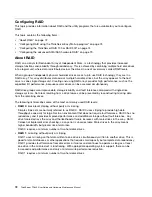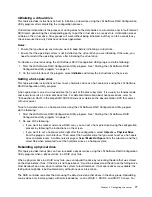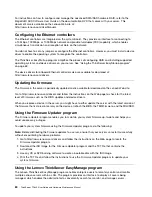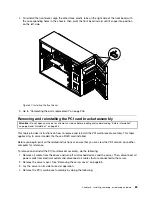
Initializing a virtual drive
This topic provides instructions on how to initialize a virtual drive using the LSI Software RAID Configuration
Utility program after completing the configuration process.
Virtual drive initialization is the process of writing zeros to the data fields of a virtual drive and, in fault-tolerant
RAID levels, generating the corresponding parity to put the virtual drive in a ready state. Initialization erases
all data on the virtual drive. Drive groups will work without being initialized, but they can fail a consistency
check because the parity fields have not been generated.
Notes:
• Ensure that you back up any data you want to keep before initializing a virtual drive.
• Ensure that the operating system is not installed on the virtual drive you are initializing. Otherwise, you
need to reinstall the operating system after initializing the virtual drive.
To initialize a virtual drive using the LSI Software RAID Configuration Utility program, do the following:
1. Start the LSI Software RAID Configuration Utility program. See “Starting the LSI Software RAID
Configuration Utility program” on page 74.
2. On the main interface of the program, select
Initialize
and follow the instructions on the screen.
Setting a hot-spare drive
This topic provides instructions on how to set a hard disk drive as a hot-spare drive using the LSI Software
RAID Configuration Utility program.
A hot-spare drive is an extra, unused drive that is part of the disk subsystem. It is usually in standby mode
and ready for service if a hard disk drive fails. For detailed information about hot-spare drives, refer to
“Introduction to RAID” in the
MegaRAID SAS Software User Guide
on the documentation DVD that comes
with your server.
To set a hard disk drive as a hot-spare drive using the LSI Software RAID Configuration Utility program,
do the following:
1. Start the LSI Software RAID Configuration Utility program. See “Starting the LSI Software RAID
Configuration Utility program” on page 74.
2. Do one of the following:
• If you want to create or add a new RAID array, you can set a hot-spare drive during the configuration
process by following the instructions on the screen.
• If you want to set a hot-spare drive right after the configuration, select
Objects
➙
Physical Drive
from the program main interface. Then, select the hard disk drive that you want to set as a hot-spare
drive and press Enter. A submenu is displayed. Select
Make Hot Spare
from the submenu, and then
select
Yes
when prompted to set the hard disk drive as a hot-spare drive.
Rebuilding a physical drive
This topic provides instructions on how to rebuild a physical drive using the LSI Software RAID Configuration
Utility program when a physical drive in a RAID array fails.
When a physical drive in a RAID array fails, you can rebuild the drive by recreating the data that was stored
on the drive before it fails. If the drive is not operational, it must be replaced and the data on the failing drive
must be rebuilt on a new drive to restore the system to fault tolerance. If hot-spare drives are available, the
failing drive might be rebuilt automatically without any user intervention.
The RAID controller recreates the data using the data stored on other drives in the drive group. Rebuilding
can be done only in drive groups with data redundancy, such as RAID 1, RAID 5, and RAID 10 arrays. For
Chapter 5
.
Configuring the server
77
Summary of Contents for 70B4
Page 16: ...4 ThinkServer TD340 User Guide and Hardware Maintenance Manual ...
Page 18: ...6 ThinkServer TD340 User Guide and Hardware Maintenance Manual ...
Page 94: ...82 ThinkServer TD340 User Guide and Hardware Maintenance Manual ...
Page 220: ...208 ThinkServer TD340 User Guide and Hardware Maintenance Manual ...
Page 230: ...218 ThinkServer TD340 User Guide and Hardware Maintenance Manual ...
Page 244: ...232 ThinkServer TD340 User Guide and Hardware Maintenance Manual ...
Page 245: ......
Page 246: ......
















































